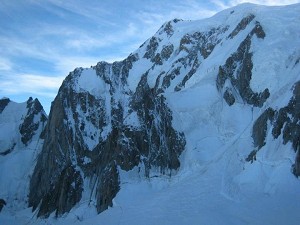
Last month we ran an account of Jerry Gore's Insulin Challenge - Divine Providence ascent. This was the first stage of Jerry personal challenge of climbing three of the most famous routes in the Alps; Divine Providence on Mont Blanc, The FIsh Route on the Marmolada and La Vida Es Silbar on the Rhote Fluh of the North Face of the Eiger.
In mid September he ticked the Eiger via an easier route with Matt Dickinson (report here on Jerry's facebook page) then, less than a month after starting, Jerry managed to make the third and final ascent of the Marmolada, again by an easier route than orginally planned - Tempi Moderni.
- More information on the challenge is here: UKC Premier Post
You can find out more or donate direct via the Insulin For Life website: insulinforlife.org
Bitter disappointment, a narrow escape from an icy grave, youthful maturity beyond years, and a tearful end to my Insulin Challenge – this is what happened!

Calum Muskett first emailed me on August 27th saying that if I needed a partner to complete my two other climbs after Divine Providence (Calum climbed it this year a week before me as it happens!) then he would be really up for it. He was really interested in La Vida es Silba on the Eiger and had the week 17-25 Sept free. I wrote back immediately as I was still desperately searching for partners. We fixed the week and Calum bought his plane ticket.
I had heard of Calum through the UK climbing grapevine. I knew he was no ordinary 19 year old, but I was not prepared for what jumped into my car at Geneva airport last Monday. Calum is arguably Wales's most talented young climber. Born and bred in Bethesda, Calum first hit the headlines when he was just 14 after on sighting the classic extreme The Cad (E6 6a) on North Stack Wall at Gogarth. He had been climbing for less than a year by this stage. I did this route aged 30 after 10 years of climbing and thought it was seriously committing!
Aged 15 and less than 7 days since his first experience on winter terrain Calum climbed the legendary Devil's Appendix (VI 6) in Cwm Idwal, a tiny sliver of ice that rarely forms and remains firmly at the very top of any Brit mountaineers dream tick list. By 2010 he was already into active new routing and created Faith, Hope and Charity (E8 6c) a super hard extreme route at a grade that only a handful of British climbers would be able to attempt. The list goes on but what all the climbing details don't convey is that this guy is way ahead of most 19 year olds in terms of his maturity, and personal direction in life. Who really knows what they want at 19. I Certainly didn't. Yet here is a young man who is sponsored by equipment companies, has already represented his country in elite fell running competitions and is focused on becoming a guide and international extreme alpinism! Sadly he also happens to be a really nice person to boot. Despite my aged faffyness, he only lost his cool once with me and then only for a few minutes before the boyish grin returned and we both got on with the immediate task in hand which at that point was Big Wall survival plain and simple!
My success with Matt Dickinson on the North Face of The Eiger had left me in a real quandary. I knew Calum had already climbed The Fish on the South Face of the Marmolada, the route that I had wanted to complete as the third climb for my Insulin Challenge, but I also knew that no route or challenge was ever justification to break a promise. Too many climbers over too many years had done that to me and I knew what it felt like. I had agreed with Calum that we would climb together at the end of September, enough said. But after I had climbed Le Chant De Cygne on the Eiger with Matt our intended objective – La Vida on the Eiger was not an option. So the question was which route to do on the Marmolada. Not a difficult problem you may think as the Marmolada is arguably the biggest, most challenging pure mountain rock wall in the Alps. It has over 200 world class routes up to 1250m. in vertical height and up to 38 pitches or rope lengths. The biggest walls anywhere in the world tend to be less than 1000 metres so 1250m. of actual pure rock climbing is gigantic.
When questioned about which route to try on the Marmolada Calum's answer was simple and immediate – Tempi Moderni – in a day! Tempi Moderni was created by Heinz Mariacher in 1982 and translates as "Modern Times". Heinz is often considered the best climber to have ever operated in the Marmolada range and he defined Tempi Moderni as his most difficult achievement. As the Marmolada guidebook writer Maurizio Giordani describes it "A route which frightens even the most prepared climber". It involves 28 pitches of climbing and almost everyone who tackles this monolith takes two days and bivvies at half height in the big shelf that runs the entire length of the mountain. Calum's project was to tackle the route in a single day and go super fast and super light taking just trainers for the descent and a thin "belay" jacket for warmth. In late September, with night time temperatures down to -10C we would not be able to last a night out on the face with such kit. So it would be a case of summit or suffer.....badly!
So the challenge had been set. Instead of The Fish, a slightly more difficult and technical route (F7b - 1220m. in length), we would attempt Modern Times (F7a - 1155m.) in a day but in late September where you get 13 hours of daylight at max. It would entail having to climb each rope length in under half an hour, both leader and second, and with pitches up to E4/5 this would be no mean feat. Especially as Tempi Moderni also gets the grade of R4 in Maurizio's guidebook which he describes as involving "Scarce or unreliable anchors; long unprotected sections; potential length of fall up to 15 meters with possibility of stripping the belay anchors; potential falls have a high possibility of injury". Moving fast over such terrain also involves good synergistic team work. As I drove up to Geneva (on Monday 17th Sept) to pick Calum up I wondered if we would even be able to communicate bearing in mind that there are 32 years difference between us and that most teenagers, including my own, tend to use mono syllables rather than normal language! We were literally generations apart. Would this partnership be able to work and work successfully given the extreme risks and stress we were about to put ourselves under?
The forecast was rain/snow midweek in the Dolomites so Tuesday Calum and I decided it wise to do a short 7 pitch multi pitch bolt protected climb close to my chalet in Vallouise. The grade was F7a, the same as Tempi Moderni, and the climb went very fast – less than 2.5 hours for 7 rope lengths. We both felt relieved that at least we could understand each other. But we knew that route finding on a "sport climb" was easy as you literally just follow the bolts. On Tempi Moderni there are no bolts and often no clue as to where the route actually goes: route finding is a big problem. Again as Maurizio the guidebook writer says "Marmolada rock....is not easy to read; it must be approached with caution, taking small steps listening to the rock's suggestions and learning to interpret them." I am a crap listener and we didn't have any margin for error – if we went off route we would not be able to do it in a day. And then we would be looking at sub zero temps with no sleeping bag or bivvy kit. More importantly one thing I could not risk was my insulin freezing as it then becomes useless.
Wednesday we headed East – 10 hours of driving (2 of which was a traffic jam due to a multiple pile up) got us to the car park in Malga Ciapella, at the start of the path that leads to the Marmolada. Thursday we hiked the 1.5 hours to the Rifugio Falier right underneath the face and dropped off our kit. Then we walked another hour up to the base of the climb and fixed the first hard pitch, a strenuous F7a finger edge maze, and then it was off back to the refuge, a good waffle of pasta and an early bed by 21.30. Both Calum and I were psyched. Tomorrow we "would" top out. We had to!
As usual I did not sleep well. Just after midnight I started to feel a bit weird so tested and found I was 140mg/dl. Pretty normal to be honest especially considering I was in "climbing mode" where I usually try to keep my blood sugars artificially a bit high; I avoid at all costs going hypo in the mountains. My fast acting insulin I had had at dinner was easily out of my system by now (it normally lasts a maximum of 3 hours) so without thinking I injected half a unit (a tiny drop literally) of fast acting and tried to get back to sleep. For at least an hour or so I tossed and turned as I debated with myself whether I had been too severe in my control or whether I had not actually injected enough bearing in mind I had eaten a lot of pasta and this can take time to convert to sugar.
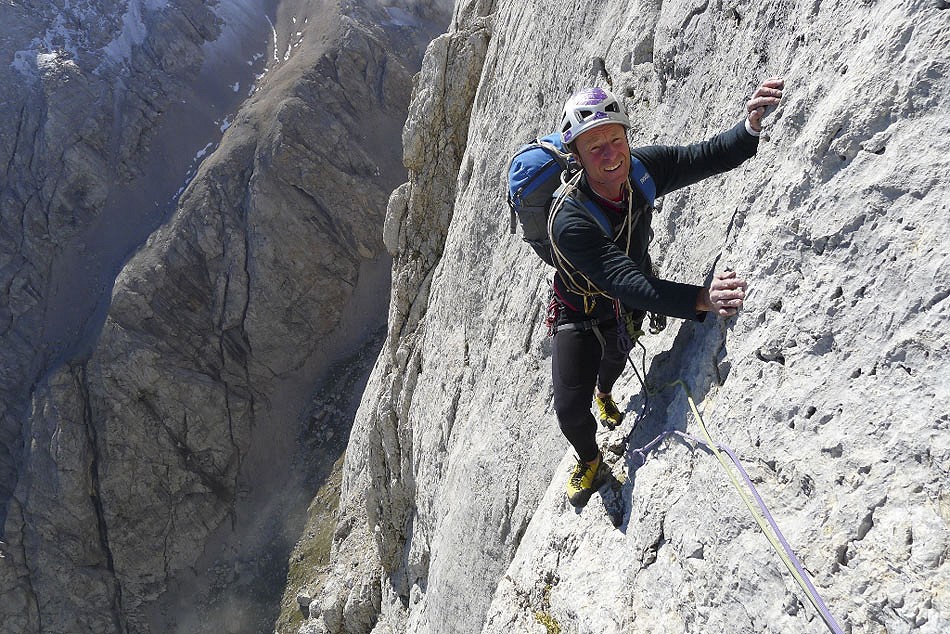
The alarm rang out at 04.30 and it was immediately action stations. I tested and was 170mg/dl – that confirmed I had injected too little in the night. Now I had to really guess right. I was quite high already and was about to eat a lot of sugary muesli. But then I would go straight into a very fast hike up to the base of the climb going at the pace of an elite 19 yr old fell runner! I injected 4 units of slow acting (levemir), half my usual day dose, and 3 units of fast acting Humalog (my usual breakfast dose of fast acting is 7 units). We packed, scoffed and shot off into the night. It felt like we were on a SAS style military raid!
We started the climb at first light – 06.45 – movement was frantic and slightly panic ridden. We had to move fast but could not afford to fall or go off route. After a long traverse off right which Matt had told me about (he had done the route last year) I arrived at the foot of a long blank section of rock. Luckily it was Calum's lead!
Now you have to remember this guy excels at trad climbing (natural protection not bolts) and he often climbs at horrendously loose crags in North Wales where most of the actual wall let alone individual holds are in imminent danger of falling down. You have to also remember that one of his main climbing partners is James McHaffie, arguably the best trad climber in the World at the moment. So when Calum shouted down to me "watch me on this, it's looking really committing" I did start to worry. No pro, technical moves and we had only just started!
One of the things about the Marmolada that makes it unique is that, because there are no bolt, climbers often have to rely on placing their own trad protection. Bolts are 100% reliable, wires and cams are not which is why the Marmolada feels so much like real mountain terrain where you just can't afford to fall. It slows progress and makes you move far slower than you can on a bolt protected sport route.
My turn next as I grabbled with a typical Marmolada F6b+ (read normal F6c+) slab move with a run out above. The hardest move involved a small smear for my left foot and a lunge for a tiny edge for my right hand. I faffed the move, lost confidence and fell luckily only a meter or so onto an in-situ piton. Annoyed with myself I tried again but this time more confidently only to find myself on slightly easier ground but now 5 meters above the piton. A 10m. fall is very different from a 1 metre one but in situations like this you just have to turn on the "trad head" and carry on. I climbed a few more metres and got a good wire in. I knew it would hold and so moved confidently up to the belay. Problem solved except the whole pitch had taken more than 45 minutes – too slow.
We reached the half way point at around 13.00. Conveniently finding a generous ledge to stretch out, we allowed ourselves the luxury of a 10 minute break. A call of nature, a cereal bar each (in total I consumed just 6), a blood test (120mg/dl – perfect), 0.5 unit of fast acting insulin, a swig of water and we were off again. Calum led a hard Fr. 6c and we were into the upper tier.

By 17.00 we had hoped to be on top but we were actually only 2/3 the way up with 8 pitches still to go. It was beginning to look dodgy. A team of two Austrians had been paralleling us the whole day – they were on the Messner route which I knew was easier than ours in the top section. We got to 6.30pm and were suddenly lost on a sea of slabs. Calum shouted over to the Austrians asking how many pitches they had left. "4 easy ones, one hard one", came the reply. The weather had turned by now and instead of clear skies we were in twilight, strong winds and no sun. I was beginning to shiver slightly. We were both undecided. I led on again but unsure about whether to go right onto slabs or escape out left. I ran the rope out – a full 60 meters with one piece of protection. Calum joined and we exchanged a few rapid words. We decided to traverse right and join the Austrians. There were only a handful of pitches left but at this rate we would be topping out in total darkness in a storm on very technical ground. I climbed out across the smooth water worn rock and almost reached the Austrians who by now were grappling with the final hard pitch – I reckon it was E3 but it is hard to grade when you can't feel your fingers and you can't control the shivering. Calum led out above me, and then I ran up an easy chimney. By now I had on my balaclava, my jacket, every stitch of clothing but the wind tore through it all. I was freezing.
The summit came a pitch later in darkness. We quickly changed into our trainers and turned our socks down over our shoes to try and stop the snow from getting in. We were on the North side of the Marmolada and it was covered in snow up to our calves. Two abseils and we were on a flat ice traverse and then snow as we ran after the Austrians in an effort to get off the hill and escape the wind. We knew we could not hang around; we were both already too cold. We reached the téléphérique station which during the day is normally host to hundreds of happy skiers and tourists. Calum and I overtook our new friends and traversed across a steep snow slope with an icy crust. I knew it was dangerous terrain but wanted to get down fast. I ran after Calum placing my feet in his footsteps. The slope changed from soft snow to ice and suddenly I was sliding. I could sense the heavily crevassed area beneath me and frantically dug my bare hands into the crust. My fingers hit harder ice and bounced out so I dug them in again but this time harder and with real anger. I was not going to lose it here on a bloody ski piste – no way! I stopped sliding and immediately got back onto my feet - a streak of Strawberry slush puppy trailed away above me through the snow as I heard Calum's voice shouting "use your nut tool, your nut tool!"
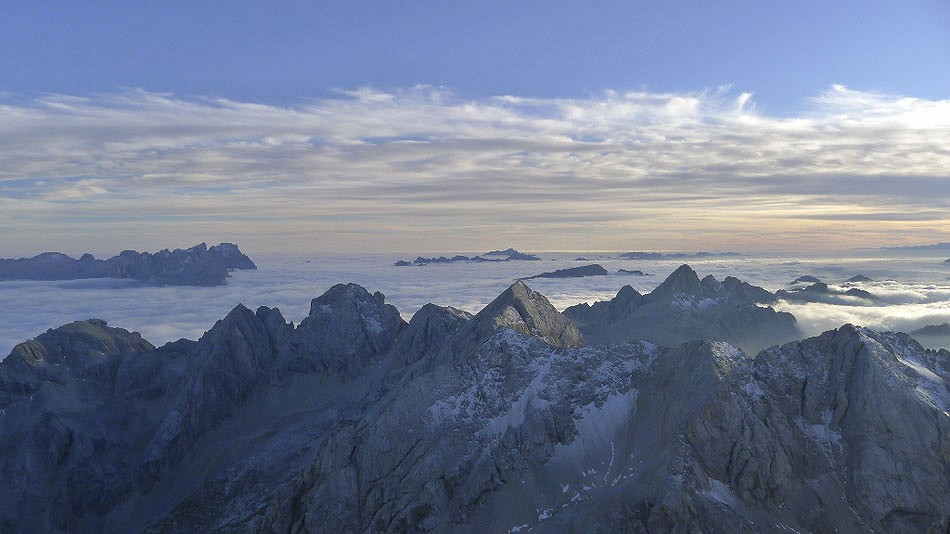
We soon got down onto the easier slopes below. No crevasses now just a long long way down. After almost 2 kilometres of descent we reached the road. Now it was just an easy 8 kilometres of downhill descent to my car. Calum said "take all the gear Jerry and I'll run up to the hut and collect our sacks. Meet you back at the car. I knew he had run for Wales but what he was proposing was Herculean. 8k's back to the car then 5k's uphill to our stashed rucksacks and then a further 5k's decent back to the car. He dropped his rope, harness and climbing gear and ran off. I followed along behind at a much slower pace with the two Austrians.
By midnight I was back at the car. The other two climbers had driven off to a warm hotel (lucky Germanic bar stewards!) and I was alone in the forest, cold but okay, waiting for Calum. I tested; 170ml/dl. High (100ml/dl is the norm) but not too bad after what I had just been through – almost 24 hours of non-stop action. I took a couple of units of fast acting insulin. I began to reflect on what we had just done and what I had achieved this summer and simply broke down – the tears cascading down my cheeks. Climbers are never satisfied and are their own worst critics. I had failed, failed to properly complete my challenge, failed to do what I set out to do. Failure, pain, frustration. It all just hit me. My right elbow was constantly inflamed now and needed surgery. My knees were wrecked and in general I felt flat – where was the elation. Where was the adrenaline, the high, the feeling of achievement? Had I done it?
This summer I had juggled family guilt (once again they had spent the summer holidays without me), work commitments (in July and August Jackie and I have over 70 residents to look after each week), diabetes, weather and partner problems. I had made the first British ascent of Emi, Ali, Leti, Pauli (ABO-), Mitchka (ED+) on the South Face of the Meije, and Le Chant Du Cygne on the Eiger. I had completed Divine Providence, a route I had wanted to climb ever since 1988 when I first spoke to Patrick Gabarrou, and now had climbed Tempi Moderni pretty much in a day. I hadn't climbed the route on the Eiger or on the Marmolada that I had originally chosen but my conclusion although slow to get to was definitive. Life is never perfect. We all have family commitments, work and time limitations, health and money issues. We all have problems in our lives and we just have to deal with them as best as we can. We don't always achieve everything we desire but what else can we do but try to achieve within the confines of life.
I would like to end this piece by saying I finished the climb easily and in control. I achieved an amazing route and all went well. But I can't because I didn't. We succeeded in making the right mountaineering decision. And for that I feel proud but we only just made it and it was silver at best not gold. But one thing for sure was clear to me at that time, sitting in a dark and damp forest alone in my thoughts - it was not my diabetes that had held me back, it was not the fact that I have to manually control my blood sugars and test and inject up to 10 times a day. Bottom line – Diabetes is a real pain in the bum, it can really depress and shut you down sometimes and inhibit you but if you have the motivation and insulin and equipment it is definitely and absolutely NOT an excuse to live an unfulfilled life.
This insulin challenge for me is over. But the journey continues and I have not stopped raising money for Insulin For Life. This autumn/winter I plan to do some UK talks and lectures to raise more funds, and next year Beth, my oldest daughter, wants to climb Mt Blanc. I hope to help her in her quest. And there will be many more challenges ahead for sure. Because in my book it is not important whether you are diabetic or not, medically challenged, physically handicapped or able bodied. It is all about following your dreams, adding your own personal piece of humanity to the mix, and the journey that that entails.
- For more photos and information - follow Jerry on Facebook.
- Insulin Challenge - Divine Providence 3 Sep, 2012
- Kendal Preview: The Ecrins XS Challenge with Jerry Gore 10 Oct, 2011
- DESTINATION GUIDE: Ecrins Ice - Europe's Finest 21 Jan, 2011



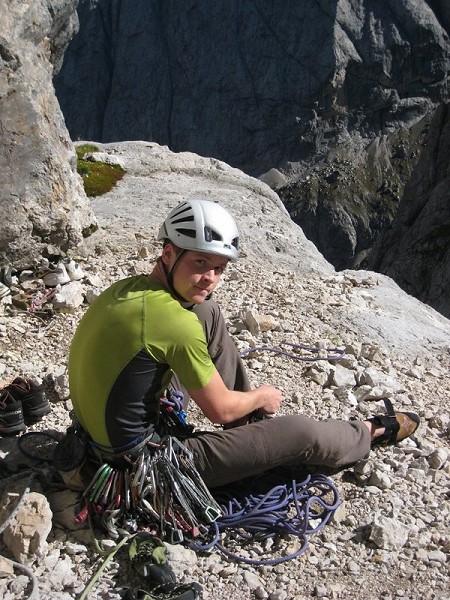
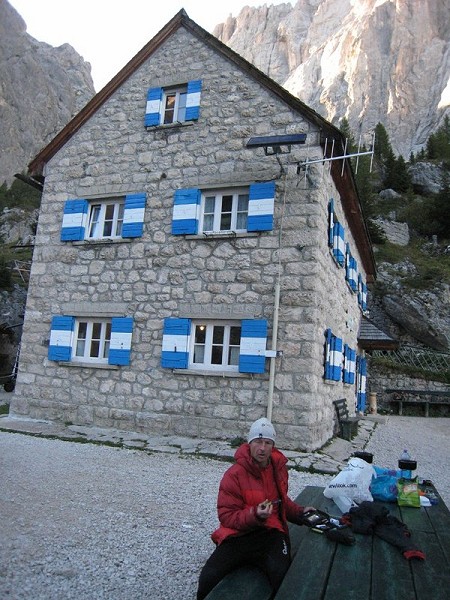

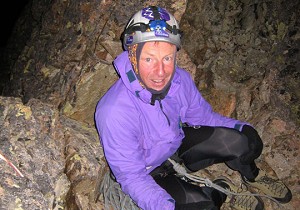
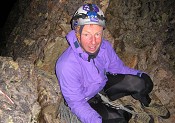








Comments